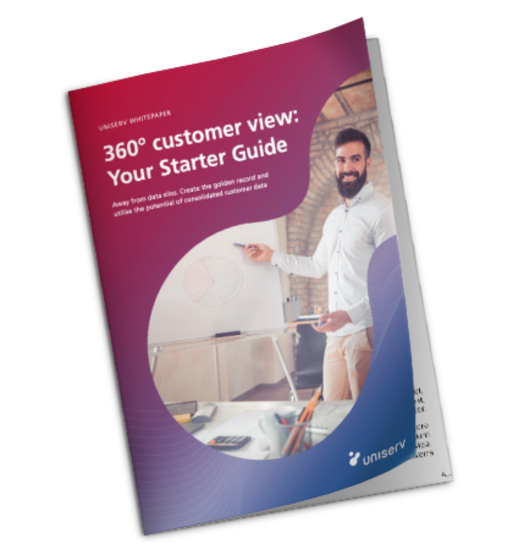Reliably identify customers and prospects with Unique ID

As a component of every customer and prospect data record, a central ID for identifying customers and prospects is indispensable. This is because data can be provided individually in each use case on the basis of a unique identification.
Lack of identification options makes it difficult to take a holistic view of customers and prospects in central business scenarios
The digital world is multi-layered. Companies have the opportunity to contact their customers in many ways. The customers themselves are just as complex. They move through the digital cosmos with different identities via different devices on different channels. It is therefore difficult to grasp a customer holistically.
In addition, data on one and the same person is often stored in several systems. This makes clear identification even more difficult, and this decentralized data storage prevents a comprehensive, consolidated view. The resulting fragmented data makes it almost impossible to see which data belongs to a person. Without a unique ID, there is also no central, identifying bracket for data consolidation.
Unique ID as a central, identifying bracket
A Unique Customer ID is a combination of digits or characters that can be used to uniquely identify persons or entities across multiple or different systems. The assignment of such an ID must be done in a way that excludes the multiple assignment of the same ID for different persons or entities. At the same time, however, a person or entity must be recognized as the same person in several systems.
The prerequisite is professional data management. It must be able to recognize and regulate which identities and thus data belong to which person without any doubt. And it must provide the holistic data sets with a unique identification number that serves as a recognition feature in the various use cases.
Identity Resolution is required to merge disparate identities. With its error-tolerant precision identification, Identity Resolution merges customer data from different sources for a unique view of a person.
With a master data hub such as the Uniserv Master Data Hub golden records can be formed and enriched with a unique ID as an identifier. In this way, you combine all data on a person, including their various identities, in one data record. And create the basis for the assignment of the Unique ID with the Golden Records.
The concrete advantages of the unique ID as a central and, above all, persistent identification feature can be seen in a wide variety of business scenarios:
360-degree customer view for marketing, sales and customer services - holistic view of every customer and business partner
A 360-degree view of each customer is relevant to success for marketing, sales and customer service and can be mapped with a Unique ID:
- Individualize customer approach and customer service
- Activate cross-sell and upsell potential
- Analyze and prevent churn
- Measure customer and prospect activity
- Professionalize support and maintenance
- Data-based management of key accounts
The data for each customer and prospect must be centrally consolidated throughout the company. Via a central Uniqe ID and a mapping table behind it, it must be clear where which information on the customer can be found and which can be accessed as needed. The more comprehensive, precise and reliable the data, the better the individual scenarios can be fulfilled.

360° customer view: Your Starter Guide
The ‘corner shop principle’ - it has never been as valuable as it is today! Want to bet? Because what Aunt Emma instinctively mastered on a small scale - the 360 degree view of each individual customer - you need to implement digitally today. As the key to personalisation in customer experience management within the customer journey.
In our Starter Guide ‘360° customer view’, you will learn how to utilise the full sales and earnings potential of consolidated customer data:
Shared customer view within a group - concentrated data power
International corporations or large B2C companies often operate out of several national subsidiaries or different brands on one and the same customer. These separate views are inefficient, tie up and devour resources. There is a risk of cannibalization effects.
The solution lies in merging customer data. The formation of a group partner or central business partner is permissible under data protection law if data management is able to ensure different access rights for the various legal entities. This can be ensured, for example, by data records that form golden records for a superordinate common unique ID that can be made available to the different legal entities.
If there is a contract for commissioned data processing (ADV contract) between the individual legal entities, most data can usually be shared across the group, and customers can be serviced jointly internationally or across brands.
Public Services: Online Access Act - Digital Access to Administrative Services
The Online Access Act (German: Onlinezugangsgesetz - OZG) obliges the federal and state governments to also offer their administrative services electronically via portals. To do this, however, the databases in municipalities and public authorities must be merged to form a uniform citizen for digital citizen services such as school registration, ID matters or driver's license exchange.
For this purpose, it is necessary to merge citizen data from a wide variety of systems and databases, and in this context to uniquely identify individual citizens or natural persons. The same applies to thousands of small businesses.
Due to the volume of data, a highly intelligent and high-performance technical solution is indispensable for this, which can (map) this unique citizen ID as an enabler in the sense of the Online Access Act.
Implementing digital self-services - consistently uniform instead of unnecessarily complex
For most companies, digital self-services initially mean the digital provision of services that were previously only possible by telephone or in sales offices and the like. These services range from the digital maintenance of a company's own contact data to the online portal and the direct purchase of products in the online store to digital product maintenance or license management.
To do this, processes have to be restructured, all the data and services of each individual customer have to be bundled into exactly one unique ID, and, protected via their customer account, displayed and made usable. A Herculean task without data management. This requires
- cleaned data per system,
- transformed into a common standard data model,
- customers clearly identified and
- the golden record being formed.
Introducing Data-Driven New Business Models - Customer Insights as a Basis
The digitization of business processes is one of the most important drivers of new business models: But what do customers want? And what do they get from a new business model? Without a reliable data basis, these questions must be answered in a blind flight. Decisions derived from the answers can be described as imprecise at best.
The real enabler of new business models is customer information generated by digitized business processes. This new knowledge about which products customers use and in what form enables the expansion of offerings to include particularly relevant services or product enhancements. In other words, the highly precise assignment of all customer activities to a unique ID is crucial to the success of new data-based business models.
Central corporate reporting - bringing together what is separate.
Corporate reporting consists of an operational view (operational data plane) and an analytical view (analytical data plane). Unfortunately, the two areas very often work separately. They use completely different systems both for the implementation of their operational tasks and for their insights and analyses. As a result, the views on the entity 'customer' differ, with separate "unique customer".
The consequences are, in particular, a duplication of resources for data preparation, a lack of a consistent view of the customer, and, depending on the department, divergent overall figures.
Using a common unique ID as a basis, both views can be merged into a central corporate reporting system. The result is a company-wide holistic view based on a uniform, reliable database. This saves time, costs and prevents dissonance.
You might also be interested in:



